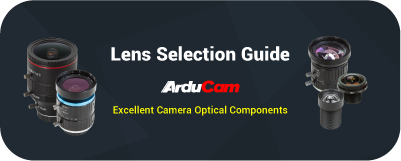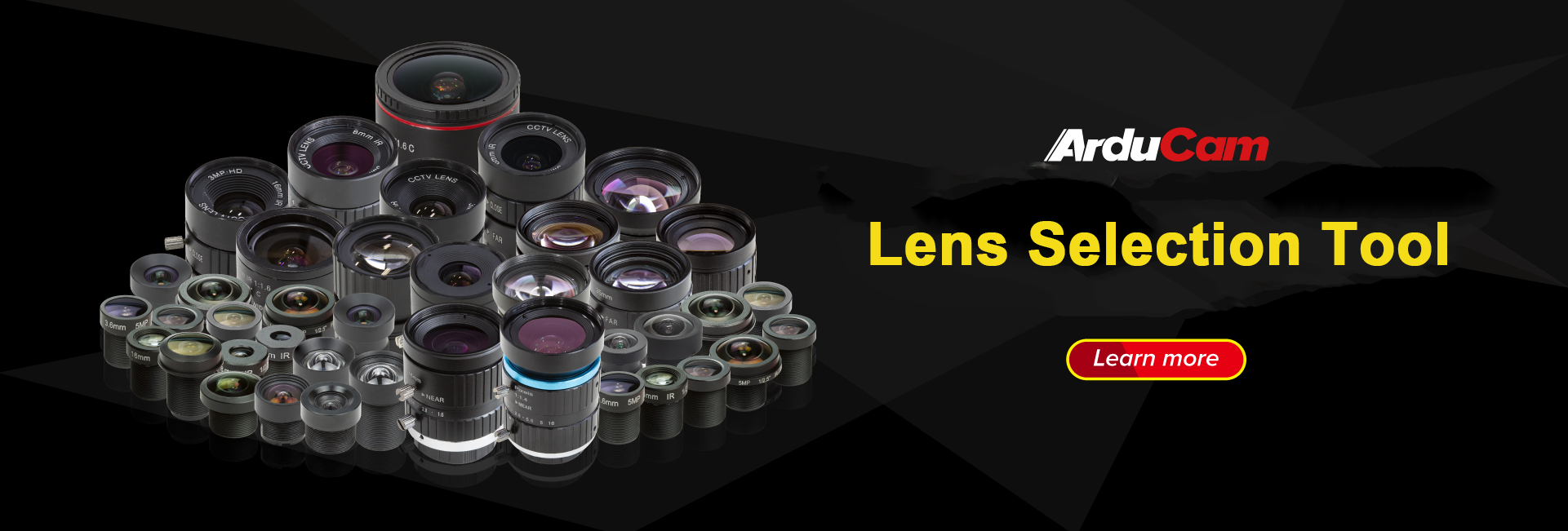
Introduction
The Lens is a crucial component in imaging systems, and its various specifications significantly impact the final imaging results and quality in various aspects. However, being one of the most complex optical elements, the inclusion of lenses in the selection process requires careful consideration of numerous factors. The Arducam team has introduced a multidimensional tool for lens selection, aiming to streamline the lens selection process for customers and assist them in choosing the most suitable lens with maximum efficiency.
If you need to get more detailed information about Lens parameters and explanations, please refer to the Major Parameters section.
Lens Selection Tool
About Lens Selection Guide
- This filtering tool is designed to help users choose the matched lens for a specific camera. We will match the lens with the optical target and image height corresponding to the specific sensor. You can enter the camera SKU in the input box below or select the lens you need to adapt directly.
- Note that these calculations are based on the assumption that the Lens is perfectly focused and the field of view is flat. In practical applications, Lens distortion and other factors will affect the effective field of view.
- The working distance is the distance between the end of the lens and the object being photographed. The maximum horizontal field of view (mm) and vertical field of view (mm) calculated from the lens FOV and camera working distance are approximate values.
Major Parameters
Sensor Optical Format
Sensor Optical Format refers to the physical dimensions of an image sensor in a camera system. The most common optical formats for image sensors are expressed in inches, such as 1/2.3 inches or 1 inch. However, it’s essential to note that these designations don’t directly correspond to the physical size of the sensor but rather serve as a standardized naming convention. Different optical formats can impact the camera’s performance, depth of field, and the types of lenses compatible with the camera.

Aspect Ratio
The aspect ratio is the proportional relationship between the width and height of an image or a display screen. It is expressed as a ratio of the image width to the height. The aspect ratio is commonly written in the form of “width: height” or as a simple fraction.
For example:
- An aspect ratio of 4:3 means that for every 4 units of width, there are 3 units of height.
- An aspect ratio of 16:9 means that for every 16 units of width, there are 9 units of height.

FOV (Field of View)
It is a measure used in optics and imaging to describe the extent of the observable world that can be seen at any given moment through a lens or optical system. The field of view is typically expressed in degrees and includes HFOV(Horizontal Field of View), VFOV(Vertical Field of View), and DFOV(Diagonal Field of View).
In the context of cameras and photography, the field of view refers to the area that the camera’s lens can capture in a single frame. A wider field of view captures more of the scene, while a narrower field of view focuses on a smaller portion of the scene. It is an important consideration in choosing lenses and camera systems, as it directly influences what will be included in the photograph or video.
The field of view is influenced by factors such as the focal length of the lens, the sensor size, and the distance between the lens and the subject. It plays a crucial role in determining how much of the surrounding environment will be visible in the final image or video.


Lens Resolution
Lens resolution, also known as optical resolution or lens sharpness, refers to the ability of a camera lens to reproduce fine details in an image. It is a measure of the lens’s ability to capture and distinguish between closely spaced elements in a scene. The resolution of a lens is influenced by factors such as the quality of its optical design, the precision of its manufacturing, and the materials used in its construction.
Lens resolution is often described in terms of line pairs per millimeter (lp/mm) or line widths per picture height (LW/PH). These metrics represent the ability of the lens to resolve alternating dark and light lines or patterns.
High-resolution lenses are capable of capturing fine details and producing sharp images with clear contrast between adjacent elements. In contrast, lower-resolution lenses may exhibit less sharpness and may struggle to render intricate details.
It’s important to note that the overall image resolution also depends on the camera sensor’s capabilities, as the lens and sensor together contribute to the final image quality. When evaluating lens resolution, it’s common to consider it in conjunction with the camera’s sensor resolution to assess the system’s overall imaging performance.
Lens Mount
A lens mount is a mechanical interface or connection system that allows a camera lens to be attached securely to a camera body. It serves as a standardized attachment point, ensuring compatibility between lenses and cameras made by different manufacturers, provided they use the same lens mount system. It includes plenty of standard mounts such as M6, M12, M16, CS Mount, C Mount, etc.
M12 Mount Lens
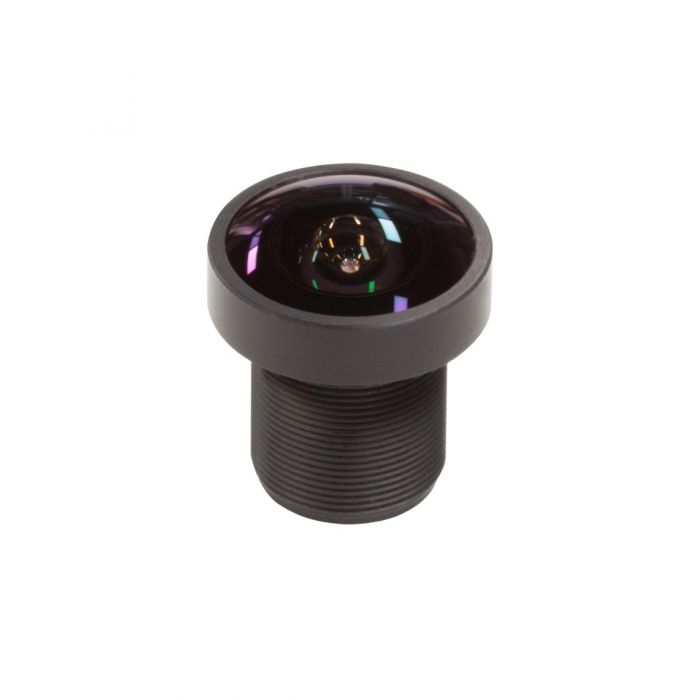
CS Mount Lens
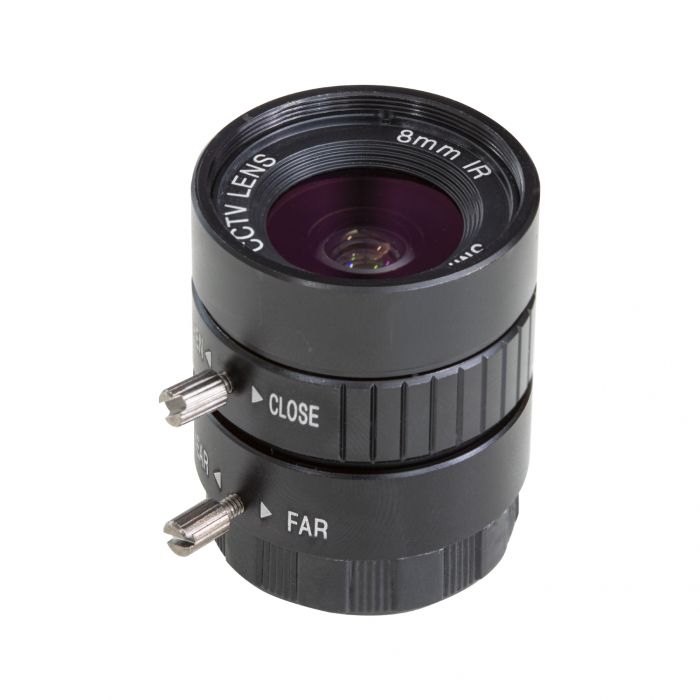
C Mount Lens
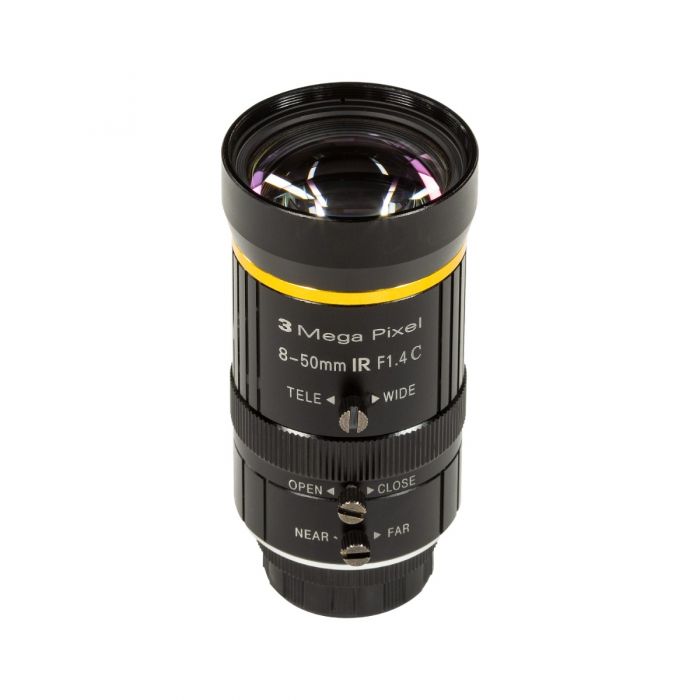
Lens Distortion
Lens distortion refers to the deviation of an optical lens from the ideal behavior of accurately reproducing straight lines. It often results in the warping or bending of images, especially towards the edges of a photograph. There are two primary types of lens distortion:
- Barrel Distortion:
Description: Barrel distortion causes straight lines to curve outward, creating a barrel-like or fish-eye effect.
- Pincushion Distortion:
Description: Pincushion distortion causes straight lines to curve inward, resembling the shape of a pincushion. Like barrel distortion, it is more evident towards the edges of the image.
Lens distortion can have both optical and geometric causes. Optical distortion results from imperfections in the lens design, while geometric distortion can occur due to the position of the lens relative to the subject or camera sensor.

Additional Resources
Lens Categories
If you require more specific camera Lenses that are on sale.
You can refer to the following Lens Categories for your choice.
Camera Selection Guide
For the full classification of the camera module, please refer to the
following Arducam Camera Selection Guide for More detail.



